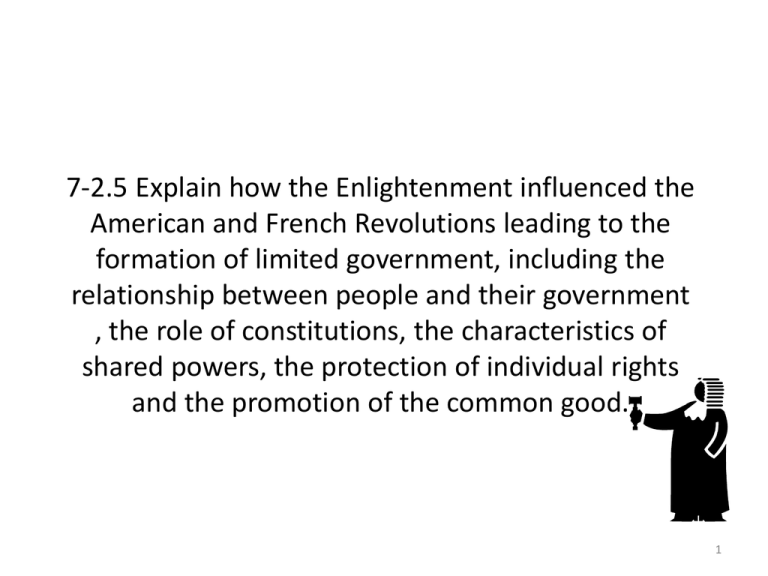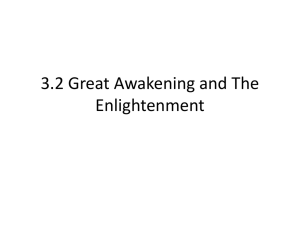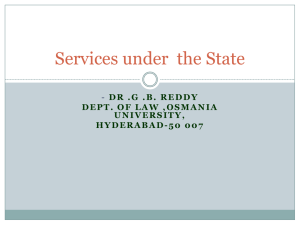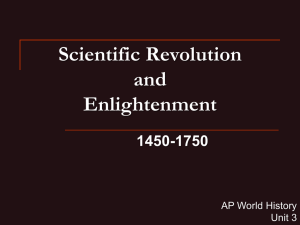7-2.5 Explain how the Enlightenment influenced the
advertisement

7-2.5 Explain how the Enlightenment influenced the American and French Revolutions leading to the formation of limited government, including the relationship between people and their government , the role of constitutions, the characteristics of shared powers, the protection of individual rights and the promotion of the common good. 1 T The American and French Revolutions: The American Revolution and the French Revolution was inspired by The Enlightenment, as well as the success of the American Revolution. American Revolution The Enlightenment French Revolution 2 • The 2 Revolutions utilized the ideas of The Enlightenment and led to the formation of limited governments and served as models for future limited governments and constitutions around the world. • The Enlightenment presented new beliefs about authority and the role of the individual in government. • John Locke presented ideas of _____, _______, and ____________. He also declared that it is the purpose of govt. to protect these rights. 3 • Locke also stated that if a government fails to protects these rights of the people, then the people could ________. • The ideas of Montesquieu, Rousseau, and Voltaire can also be seen in the formation of limited forms of government. • Many of the limited governments became representative democracies where citizens choose other citizens to represent them in the decision-making processes of government. • These Enlightenment ideas inspired the leaders of the American Revolution served as a model for the French and many other revolutions that followed such as those in Latin America. • The American Revolution drew upon John Locke’s belief in the Declaration of Independence. Thomas Jefferson’s made specific references to Locke’s ideas to argue that the colonists were rebelling because their rights had been violated and that they therefore had the right to alter or abolish their government. 4 • A growing number of French citizens had embraced the Enlightenment ideas of “equality” and “freedom of the individual” as presented by Voltaire and other philosophers. • Contact between American revolutionaries and French troops supported and helped spread these ideals to the French people. • Many French citizens began to attack the undemocratic nature of their own government which led to the French Revolution. • Following these revolutions, the ideas of the Enlightenment were used to develop limited governments and constitutions. 5 Constitutions: • A constitution that creates a limited govt. as the relationship between the people and their govt. embodies Locke’s idea of a social contract, as a constitution is an agreement between the govt. and the people. • The role is to place limits on the govt.’s power by outlining what powers the govt. does/does not have, or what the govt. can/can’t do. • A constitution is the “law” which establishes the structure and operation of govt. and details the relationship of the people to their govt. • Constitutions are critical because they provide the govt. legitimacy in ruling but they do have provisions to several key components: 6 • Can be a single written document like in the US. • A collection of traditions, precedents, legal rulings and documents that together make what is known as an unwritten constitution like in England. • Both forms are legitimate. • The US had the first written constitution and helped set the foundation for what national constitutions generally address. • Many principles and ideas of the US Constitution were based on traditions and heritage of the unwritten English constitution. • When govt. first became responsive to the will of the people was when King John signed the Magna Carta (Great Charter) in 1215. • Not all constitutions are legitimate and it is possible for a govt. to have a written constitution , but not all follow the principles or guidelines set forth in it. The Soviet Union is an example of this. 7 Constitutions can be classified as either be “positive” or “negative”: POSITIVE: 1. Centers on the roles and responsibilities that a government is to perform. NEGATIVE: 1. Focuses on the limitations placed on governments. Example: Providing a universal education for all citizens. 8 Key Components of Constitutions: • Provide a framework for the operation of the legislative, executive, judicial branches. • Establish relationships between the national govt. and the regional/provincial govt.’s • They define the relationship of govt. to the citizens and the rights of the citizens. • The characteristics of shared powers are evident in the creation of the 3 branches of govt. • The 3 branches clearly take influence from Montesquieu’s idea of separation of powers. 9








